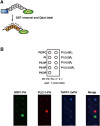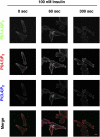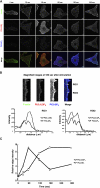Quantification and visualization of phosphoinositides by quantum dot-labeled specific binding-domain probes
- PMID: 22308508
- PMCID: PMC3307658
- DOI: 10.1194/jlr.D019547
Quantification and visualization of phosphoinositides by quantum dot-labeled specific binding-domain probes
Abstract
Phosphoinositides (PI) play important regulatory roles in cell physiology. Localization and quantitation of PIs within the cell is necessary to understand their precise function. Currently, ectopic expression of green fluorescent protein (GFP)-fused PI-binding domains is used to visualize PIs localized to the cell membrane. However, ectopically expressed PI-binding domains may compete with endogenous binding proteins, thus altering the physiological functions of the PIs. Here, we establish a novel method for quantification and visualization of PIs in cells and tissue samples using PI-binding domains labeled with quantum dots (Qdot) as specific probes. This method allowed us to simultaneously quantify three distinct PIs, phosphatidylinositol 3,4,5-triphosphatase [PtdIns(3,4,5)P(3)), PtdIns(3,4)P(2), and PtdIns(4,5)P(2), in crude acidic lipids extracted from insulin-stimulated cells. In addition, the method allowed the PIs to be visualized within fixed cells and tissues. Sequential and spatial changes in PI production and distribution were detected in platelet-derived growth factor (PDGF)-stimulated NRK49F cells. We also observed accumulation of PtdIns(3,4)P(2) at the dorsal ruffle in PDGF-stimulated NIH3T3 cells. Finally, we found PtdIns(3,4,5)P(3) was enriched in lung cancer tissues, which also showed high levels of phosphorylated Akt. Our new method to quantify and visualize PIs is expected to provide further insight into the role of lipid signaling in a wide range of cellular events.
Figures









Similar articles
-
The pleckstrin homology domains of protein kinase B and GRP1 (general receptor for phosphoinositides-1) are sensitive and selective probes for the cellular detection of phosphatidylinositol 3,4-bisphosphate and/or phosphatidylinositol 3,4,5-trisphosphate in vivo.Biochem J. 1999 Dec 15;344 Pt 3(Pt 3):929-36. Biochem J. 1999. PMID: 10585883 Free PMC article.
-
Confocal imaging of the subcellular distribution of phosphatidylinositol 3,4,5-trisphosphate in insulin- and PDGF-stimulated 3T3-L1 adipocytes.Biochem J. 1999 Dec 1;344 Pt 2(Pt 2):511-8. Biochem J. 1999. PMID: 10567235 Free PMC article.
-
A monoclonal antibody to visualize PtdIns(3,4,5)P(3) in cells.J Histochem Cytochem. 2002 May;50(5):697-708. doi: 10.1177/002215540205000511. J Histochem Cytochem. 2002. PMID: 11967281
-
Phosphatidylinositol Kinases and Phosphatases in Entamoeba histolytica.Front Cell Infect Microbiol. 2019 Jun 6;9:150. doi: 10.3389/fcimb.2019.00150. eCollection 2019. Front Cell Infect Microbiol. 2019. PMID: 31245297 Free PMC article. Review.
-
Arranged marriage in lipid signalling? The limited choices of PtdIns(4,5)P2 in finding the right partner.Plant Biol (Stuttg). 2013 Sep;15(5):789-97. doi: 10.1111/plb.12025. Epub 2013 Apr 29. Plant Biol (Stuttg). 2013. PMID: 23627419 Review.
Cited by
-
Polyphosphoinositide binding domains: Key to inositol lipid biology.Biochim Biophys Acta. 2015 Jun;1851(6):746-58. doi: 10.1016/j.bbalip.2015.02.013. Epub 2015 Feb 27. Biochim Biophys Acta. 2015. PMID: 25732852 Free PMC article. Review.
-
Network analysis of the focal adhesion to invadopodia transition identifies a PI3K-PKCα invasive signaling axis.Sci Signal. 2012 Sep 11;5(241):ra66. doi: 10.1126/scisignal.2002964. Sci Signal. 2012. PMID: 22969158 Free PMC article.
-
Class II PI3Ks at the Intersection between Signal Transduction and Membrane Trafficking.Biomolecules. 2019 Mar 15;9(3):104. doi: 10.3390/biom9030104. Biomolecules. 2019. PMID: 30884740 Free PMC article. Review.
-
Probing and imaging phospholipid dynamics in live cells.Life Metab. 2024 Apr 13;3(4):loae014. doi: 10.1093/lifemeta/loae014. eCollection 2024 Aug. Life Metab. 2024. PMID: 39872507 Free PMC article. Review.
-
Differences in levels of phosphatidylinositols in healthy and stable Coronary Artery Disease subjects revealed by HILIC-MRM method with SERRF normalization.PLoS One. 2021 Jun 4;16(6):e0252426. doi: 10.1371/journal.pone.0252426. eCollection 2021. PLoS One. 2021. PMID: 34086718 Free PMC article.
References
-
- Janmey P. A., Lindberg U. 2004. Cytoskeletal regulation: rich in lipids. Nat. Rev. Mol. Cell Biol. 5: 658–666 - PubMed
-
- Di Paolo G., De Camilli P. 2006. Phosphoinositides in cell regulation and membrane dynamics. Nature. 443: 651–657 - PubMed
-
- Lazar D. F., Saltiel A. R. 2006. Lipid phosphatases as drug discovery targets for type 2 diabetes. Nat. Rev. Drug Discov. 5: 333–342 - PubMed
-
- Ooms L. M., Horan K. A., Rahman P., Seaton G., Gurung R., Kethesparan D. S., Mitchell C. A. 2009. The role of the inositol polyphosphate 5-phosphatases in cellular function and human disease. Biochem. J. 419: 29–49 - PubMed
Publication types
MeSH terms
Substances
LinkOut - more resources
Full Text Sources
Research Materials
Miscellaneous

